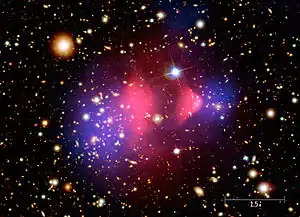X17 particle
The X17 particle is a hypothetical subatomic particle proposed by Attila Krasznahorkay and his colleagues to explain certain anomalous measurement results.[2][3] The particle has been proposed to explain wide angles observed in the trajectory paths of particles produced during a nuclear transition of beryllium-8 atoms and in stable helium atoms.[4] The X17 particle could be the force carrier for a postulated fifth force, possibly connected with dark matter,[4] and has been described as a protophobic (i.e., ignoring protons)[5] X boson with a mass near 17 MeV.[4]
| Composition | Elementary particle |
|---|---|
| Interactions | Fifth force |
| Status | Hypothetical |
| Symbol | X17 |
| Theorized | 2015 |
| Mass | 16.84±0.36 MeV[1] |
| Mean lifetime | 10−14 s[2] |
| Electric charge | 0 e |
History
In 2015, Krasznahorkay and his colleagues at ATOMKI, the Hungarian Institute for Nuclear Research, posited the existence of a new, light boson with a mass of about 17 MeV (i.e. 34 times heavier than the electron).[6] In an effort to find a dark photon, the team fired protons at thin targets of lithium-7, which created unstable beryllium-8 nuclei that then decayed and produced pairs of electrons and positrons.[2] Excess decays were observed at an opening angle of 140° between the e+ and e− particles and a combined energy of approximately 17 MeV. This indicated that a small fraction of beryllium-8 might shed its excess energy in the form of a new particle. The result was successfully repeated by the team.[4]
In 2016, Jonathan Feng et al. proposed that a protophobic X-boson, with a mass of 16.7 MeV, suppressed couplings to protons relative to neutrons, and electrons at femtometer range, could explain the data. The force may explain the g−2 muon anomaly and provide a dark matter candidate. As of 2019, several research experiments are underway to attempt to validate or refute these results.[6][7]
In October 2019, Krasznahorkay posted a preprint announcing that he and his team at ATOMKI had successfully observed the same anomalies in the decay of stable helium atoms as had been observed in beryllium-8, strengthening the case for the existence of the X17 particle.[1] This was covered in science journalism, focusing largely on the implications that the existence of the X17 particle and a corresponding fifth force would have in the search for dark matter.[8][9][10]
Criticism
As of December 2019, the ATOMKI paper describing the particle has not been peer reviewed and should therefore be considered preliminary.[11] Furthermore, efforts by CERN and other groups to independently detect the particle have been unsuccessful so far.[12]
The ATOMKI group had claimed to find various other new particles earlier in 2016 but abandoned these claims later, without an explanation of what caused the spurious signals. The group has also been accused of cherry-picking results that support new particles while discarding null results.[5][13]
The X17 particle is not consistent with the Standard Model, so its existence would need to be explained by another theory.[3]
References
- Krasznahorkay, A.J.; et al. (23 October 2019). "New evidence supporting the existence of the hypothetic X17 particle". arXiv:1910.10459v1 [nucl-ex].
- Krasznahorkay, A.J.; et al. (26 January 2016). "Observation of Anomalous Internal Pair Creation in 8Be: A Possible Indication of a Light, Neutral Boson". Physical Review Letters. 116 (42501): 042501. arXiv:1504.01527. Bibcode:2016PhRvL.116d2501K. doi:10.1103/PhysRevLett.116.042501. PMID 26871324. S2CID 206268170.
- O'Callaghan, Jonathan. "Evidence of New X17 Particle Reported, but Scientists Are Wary". Scientific American. Retrieved 9 December 2019.
- Cockburn, Harry (21 November 2019). "Scientists may have discovered fifth force of nature, laboratory announces". The Independent. Retrieved 21 November 2019.
- Wolchover, Natalie (7 June 2016). "Evidence of a 'Fifth Force' Faces Scrutiny - A lab in Hungary has reported an anomaly that could lead to a physics revolution. But even as excitement builds, closer scrutiny has unearthed a troubling backstory". Quanta Magazine. Retrieved 20 November 2019.
- Cartlidge, Edwin (2016). "Has a Hungarian physics lab found a fifth force of nature?". Nature. doi:10.1038/nature.2016.19957. S2CID 124347962.
- J. L. Feng; et al. (2016). "Protophobic Fifth Force Interpretation of the Observed Anomaly in 8Be Nuclear Transitions". Physical Review Letters. 117 (7): 071803. arXiv:1604.07411. Bibcode:2016PhRvL.117g1803F. doi:10.1103/PhysRevLett.117.071803. PMID 27563952. S2CID 206279817.
- McRae, Mike (20 November 2019). "Physicists Claim They've Found Even More Evidence of a New Force of Nature". ScienceAlert.com. Retrieved 20 November 2019.
- Prior, Ryan (22 November 2019). "A 'no-brainer Nobel Prize': Hungarian scientists may have found a fifth force of nature". CNN News. Retrieved 22 November 2019.
- Malewar, Amit (21 November 2019). "Scientists may have discovered the fifth force of nature - It's not the first time researchers claim to have caught a glimpse of it". TechExplorist.com. Retrieved 23 November 2019.
- "Mysterious 'Particle X17' Could Carry a Newfound Fifth Force of Nature, But Most Experts Are Skeptical | Live Science". www.livescience.com. Retrieved 9 December 2019.
- Banerjee, D.; Burtsev, V. E.; Chumakov, A. G.; Cooke, D.; Crivelli, P.; Depero, E.; Dermenev, A. V.; Donskov, S. V.; Dusaev, R. R.; Enik, T.; Charitonidis, N. (8 June 2018). "Search for a Hypothetical 16.7 MeV Gauge Boson and Dark Photons in the NA64 Experiment at CERN". Physical Review Letters. 120 (23): 231802. arXiv:1803.07748. Bibcode:2018PhRvL.120w1802B. doi:10.1103/PhysRevLett.120.231802. ISSN 0031-9007. PMID 29932721. S2CID 49380594.
- Siegel, Ethan (26 November 2019). "This is Why the 'X17' Particle and a New, Fifth Force Probably Don't Exist". Forbes. Retrieved 28 November 2019.
